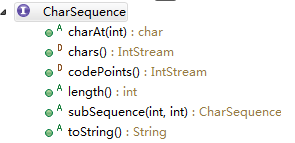【jdk1.8】String原始碼分析
阿新 • • 發佈:2019-01-03
String
類的宣告
public final class String
implements java.io.Serializable, Comparable<String>, CharSequence首先可以看到String類是一個不變類,被final修飾,所以是不可繼承的。
它實現了Serializable介面,還有Comparable(主要就是compareTo方法)與CharSequence(如下圖)。
類的成員變數
/** 底層字元的儲存*/
private final char value[];
/** 雜湊碼*/ 類的構造方法
主要有三類類的構造方法,第一種是和byte[]相關的,第二種是和char[]相關的,第三種是和StringBuilder和StringBuffer相關的。
byte[]類
byte[]類裡比較重要或者說比較常用的一個方法就是解碼了。
public String(byte bytes[], String charsetName)
throws UnsupportedEncodingException {
this(bytes, 0, bytes.length, charsetName);
}
public 我們來看一個例子:
String test = "中文";
String[] csn = new String[] {"ISO-8859-1", "GBK", "UTF-8"};
for(int i=0;i<csn.length;i++){
byte[] bt = test.getBytes(csn[i]);
for(int j=0;j<csn.length;j++){
String str = new String(bt, csn[j]);
String res = new String(str.getBytes(csn[j]), csn[i]);
System.out.print(res+"\t");
}
System.out.println();
}結果是:
ISO GBK UTF-8
ISO ?? ?? ??
GBK 中文 中文 錕斤拷錕斤拷
UTF-8 中文 中文 中文為什麼ISO-8859-1那一行編碼組合再還原都不行呢?
因為ISO-8859-1編碼的編碼表中,沒有包含漢字字元,當然也就無法通過["中文".getBytes("ISO8859-1");]來得到正確的”中文”在ISO-8859-1中的編碼值了,所以再通過new String()來還原就無從談起了。
char[] 和 StringXxx
主要就是Arrays.copyOf()的應用咯。
類的關鍵方法
hashCode()
public int hashCode() {
int h = hash;
if (h == 0 && value.length > 0) {
char val[] = value;
for (int i = 0; i < value.length; i++) {
h = 31 * h + val[i];
}
hash = h;
}
return h;
}其實就是公式s[0]*31^(n-1) + s[1]*31^(n-2) + ... + s[n-1]的值。
intern()
/**本地方法*/ /**
* Returns a canonical representation for the string object.
* <p>
* A pool of strings, initially empty, is maintained privately by the
* class {@code String}.
* <p>
* When the intern method is invoked, if the pool already contains a
* string equal to this {@code String} object as determined by
* the {@link #equals(Object)} method, then the string from the pool is
* returned. Otherwise, this {@code String} object is added to the
* pool and a reference to this {@code String} object is returned.
* <p>
* It follows that for any two strings {@code s} and {@code t},
* {@code s.intern() == t.intern()} is {@code true}
* if and only if {@code s.equals(t)} is {@code true}.
* <p>
* All literal strings and string-valued constant expressions are
* interned. String literals are defined in section 3.10.5 of the
* <cite>The Java™ Language Specification</cite>.
*
* @return a string that has the same contents as this string, but is
* guaranteed to be from a pool of unique strings.
*/
public native String intern();
